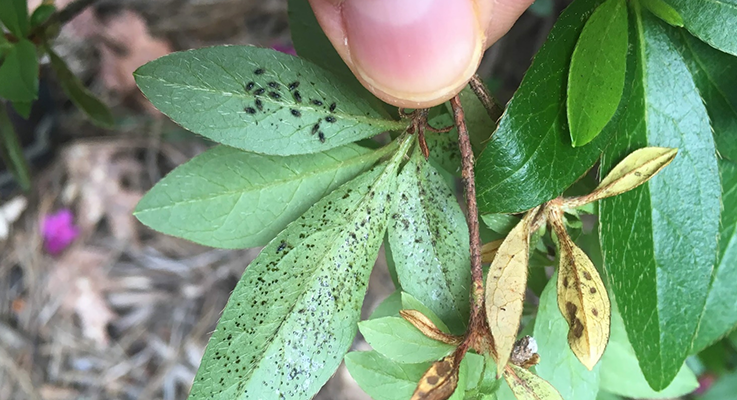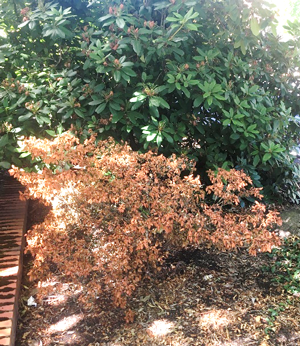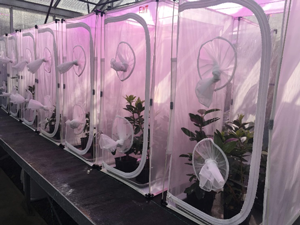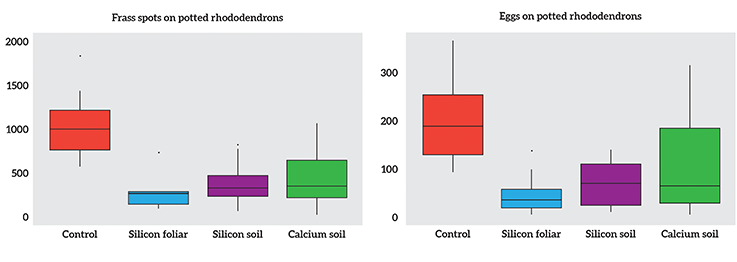
Rhododendrons and azaleas are the backbone of many ornamental landscapes in the Pacific Northwest. Unfortunately, since 2016, a beautiful little insect has been plaguing the genus Rhododendron, causing aesthetic and physiological damage, which may lead to plant death if left unchecked (Figure 1).
Preliminary studies suggest that cultivars vary in their tolerance to azalea lace bug (Stephanitis pyrioides), but in many, the molting and feeding activity of nymphs and adults leave a sticky mess on the leaves’ underside (Figure 2). Landscape structure may also have an impact on the degree of damage due to the variable amounts of sun exposure and presence/absence of natural enemies which influence lace bug populations.
Presently landscape managers and homeowners have few tools at their disposal. Acephate effectively controls nymphs and adults and systemic neonicotinoids control all stages, but both are losing favor among the general public due to their hard chemistries and associated environmental and health effects. Insect growth regulators (IGRs) may offer a softer alternative but have the potential to impact other insects with similar physiologies.
Silicon and its role in enhanced resistance
Silicon is the second most abundant element on Earth. It is found in most terrestrial plants, but at different concentrations; monocots tend to accumulate more of it than dicots. Silicon accumulates in leaf and stem tissue as microscopic solid silicon, knowns as phytoliths, after traveling up from the root as dissolved silicic acid.

Supplementing plants with silicon has been suggested to improve plant health and, may have added benefits in negatively impacting plant-feeding pests. Yet, the use of silicon for enhanced resistance has had mixed results.
Feeding strategy is one of the factors at play. Most chewing insects that gnaw through leaf or stem cuticle are affected by silicon supplementation, suggesting that phytoliths may be causing irreversible wear of the mandibles. For example, the caterpillars of the fall armyworm on corn, African pink stem borer on maize, and African sugarcane boreron sugarcaneexperienced either increased mortality, mandibular wear, reduced larval survival and growth rate, delayed penetration, or all the above.
Folivores which feed on soft tissues between the epidermal layers don’t experience damage to their mouthparts, however their population may still be affected by silicon due to a decrease in oviposition as has been shown with the leaf miner American serpentine leaf miner on chrysanthemum and zinnia.
Sucking insects such as the phloem feeding English grain aphid, rose-grain aphidandgreenbugon wheat and green peach aphid on zinnia experienced reduce infestation, lower longevity and fecundity, decreased probing time, increased frequency in stylet withdrawal or activation of the plant defense system.
Xylem feeders such as the white-backed planthopper and brown planthopper on rice experienced decreased food intake, inhibited sucking behavior, decreased adult longevity, fecundity and population growth.
The two-spotted spider mite also had significant population reductions.
In some cases, no effects have been reported: the caterpillars of dusky herpetogramma moth and black cutwormon turfgrass had no visible feeding preference, mandibular wear, growth or survival.
In short, silicon supplemented as a soil drench can result in solid silicon, causing irreversible wear of the mandibles of chewing insects, interfering with feeding activities of sucking insects or lowering oviposition regardless of feeding type. As well, soil drenches could trigger changes in leaf chemistries due to the added dissolved silicon, leading to lower palatability and digestibility. Dissolved silicon may also help trigger induced defenses resulting in the release of herbivore induced plant volatiles as documented with the cotton bollworm and the predatory red and blue beetle.
In some instances, a foliar spray application may be more effective than a soil drench, suggesting either a topical effect or translaminar penetration. This was the case with the silverleaf whitefly on cucumber and the American serpentine leaf miner on Gerbera jamesonii which experienced significant reductions in oviposition and survival rate and significant reductions in tunneling respectively.
Silicon and the azalea lace bug
Our first-year study showed that silicon supplementation is promising for azalea lace bug control. Two varieties of rhododendron, ‘Cunningham white’ and ‘Boule de Niege’, were supplemented with calcium silicate four times once a week.

Applications were delivered as a foliar spray or a soil drench. A calcium carbonate group was included to discard the possible effect of calcium. Frass spots and eggs were tallied for the three treatments and a control 30 days after releasing azalea lace bug into an enclosure with 4-inch pot rhododendrons (Figure 3).

Analysis of silicon content showed supplementation had not resulted in accumulation in leaf tissue. Frass spots, which indicate feeding activity, and egg counts were lower in all three treatments, with silicon foliar resulting in lower counts overall (Figure 4).
Further research is being conducted to confirm these preliminary findings and to determine the most effective dosage under greenhouse conditions; field tests will follow thereafter. Stay tuned!
Katerina Velasco-Graham is a research technician at the USDA ARS Horticultural Crops Research Unit, and completed a M.S. on azalea lace bug control at Oregon State University, [email protected]. Jana Lee is a research entomologist at the USDA ARS Horticultural Crops Research Unit focused on biologically-based control of small fruit and ornamental pests.


